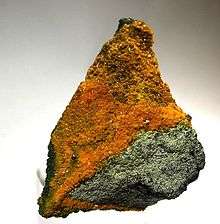Pascoite
Pascoite is a mineral with formula Ca3V10O28·17H2O that is red-orange to yellow in color. It was discovered in the Pasco Province of Peru, for which it is named, and described in 1914.
| Pascoite | |
|---|---|
Pascoite from D-day N. 2 mine, Utah, U.S. | |
| General | |
| Category | Vanadate minerals |
| Formula (repeating unit) | Ca3V10O28·17 H2O |
| Strunz classification | 4.HC.05 |
| Dana classification | 47.2.1.1 |
| Crystal system | Monoclinic |
| Crystal class | Prismatic (2/m) (same H-M symbol) |
| Space group | C2/m[1] |
| Unit cell | a = 16.834 Å, b = 10.156 Å, c = 10.921 Å, β = 93.13°; Z = 2 |
| Identification | |
| Cleavage | Distinct on {010}[2] |
| Fracture | Conchoidal |
| Mohs scale hardness | 2.5 |
| Luster | Sub-Adamantine, Vitreous |
| Streak | Cadmium-yellow |
| Diaphaneity | Translucent |
| Density | 2.455 (measured) |
| Optical properties | Biaxial (-) |
| Refractive index | nα = 1.775 nβ = 1.815 nγ = 1.825 |
| Birefringence | δ = 0.050 |
| Pleochroism | Visible |
| 2V angle | 50° to 56° (measured) |
| Dispersion | r < v strong |
| Solubility | Soluble in water |
| References | [3][4] |
Description

Crystals of pascoite, which occur in granular crusts, are minute and lath-like with oblique terminations. The mineral is dark red-orange to yellow-orange in color and dirty yellow when partially dehydrated. It occurs as efflorescences in mine tunnels or as a product leached out of surficial vanadium oxides by ground water. Pascoite has been found in association with carnotite.[2]
Pascoite melts readily to form a deep red liquid.[5]
Pascoite is a member of the eponymous pascoite group.[4] The magnesium analogue of pascoite is magnesiopascoite.[6]
Structure
A 2005 study determined that pascoite has a C 2/m disordered crystal structure. It consists of decavanadate anions (V10O28)6− linked together by the interstitial complex {Ca3(H2O)17}6+.[7]
Synthesis
Pascoite can be easily synthesized by leaching oxides of calcium and vanadium with water to produce an orange-colored solution with an pH of about 4.6. Evaporation of the solution at room temperature produces orange-red crystals of the mineral. Dissolved pascoite can also be recrystallized from water.[8]
History
Pascoite was discovered in the Ragra mine near Cerro de Pasco, Peru, where the mineral formed on the walls of an exploratory tunnel after its excavation.[6] The specimens were transported by D. Foster Hewett from Peru to the United States Geological Survey laboratory for analysis. Several years later, in 1914, pascoite was described in the Proceedings of the American Philosophical Society. It was named for the Pasco Province in which it was discovered.[9]
Distribution
Pascoite has been found in Argentina, the Czech Republic, Italy, Peru, the UK and the US.[4][6] Several of the sites from which it has been reported are uranium mining districts.[6] The type material is held in the United States at Harvard University in Massachusetts and the National Museum of Natural History in Washington, D.C.[2]
References
- Citations
- "Pascoite". Webmineral. Retrieved July 9, 2012.
- "Pascoite" (PDF). Handbook of Mineralogy. Mineral Data Publishing. Retrieved July 9, 2012.
- Mineralienatlas
- "Pascoite". Mindat. Retrieved July 9, 2012.
- Hillebrand, Merwin & Wright 1914, p. 51.
- Kampf & Steele 2008, p. 680.
- Hughes, Schindler & Francis 2005, p. 1379.
- Swallow, Ahmed & Barnes 1966, p. 397.
- Hillebrand, Merwin & Wright 1914, p. 49.
- Bibliography
- Hillebrand, W. F.; Merwin, H. E.; Wright, Fred E. (January–May 1914). "Hewettite, Metahewettite and Pascoite, Hydrous Calcium Vanadates". Proceedings of the American Philosophical Society. American Philosophical Society. 53 (213): 31–54. JSTOR 984129.CS1 maint: ref=harv (link)
- Hughes, John M.; Schindler, Michael; Francis, Carl A. (August 2005). "The C2/M Disordered Structure of Pascoite, CA3[V10O28]·17H2O: Bonding Between Structural Units and Interstitial Complexes in Compounds Containing the [V10O28]6− Decavanadate Polyanion". The Canadian Mineralogist. 43 (4): 1379–1386. doi:10.2113/gscanmin.43.4.1379.CS1 maint: ref=harv (link) (subscription required)
- Kampf, Anthony R.; Steele, Ian M. (June 2008). "Magnesiopascoite, a new Member of the Pascoite Group: Description and Crystal Structure". The Canadian Mineralogist. 46 (3): 679–686. doi:10.3749/canmin.46.3.679.CS1 maint: ref=harv (link) (subscription required)
- Swallow, A. G.; Ahmed, F. R.; Barnes, W. H. (September 1966). "The crystal structure of pascoite, Ca3V10O28·16H2O". Acta Crystallographica. 21 (3): 397–405. doi:10.1107/S0365110X66002974.CS1 maint: ref=harv (link) (subscription required)
External links
![]()